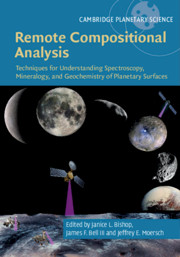 Remote Compositional Analysis
Remote Compositional Analysis Iron Mineralogy, Oxidation State, and Alteration on Mars
from Part IV - Applications to Planetary Surfaces
Published online by Cambridge University Press: 15 November 2019
Mössbauer instruments were included on the Mars Exploration Rover (MER) Mission to determine the mineralogic composition, diversity, and oxidation state of Fe-bearing igneous materials and alteration products. A total of 16 Fe-bearing phases (consistent with bulk-sample chemistry) were identified, including Fe associated with rock-forming minerals (olivine, pyroxene, magnetite, ilmenite, and chromite), Fe3+-bearing oxyhydroxides (nanophase ferric oxide, hematite, and goethite), sulfates (jarosite and an unassigned Fe3+ sulfate phase), and Fe2+ carbonate. Igneous rock types ranged from basalts to ultramafic rocks at Gusev crater. Jarosite-hematite bedrock was pervasive at Meridiani Planum, and concretions winnowed from the outcrop were mineralogically hematite. Because their structures contain hydroxyl, goethite, and jarosite provide mineralogic evidence for aqueous processes on Mars, and jarosite and Fe3+ sulfate are evidence for acid-sulfate processes at both Gusev crater and Meridiani Planum. A population of rocks on the Meridiani Planum outcrop was identified as iron and stony meteorites by the presence of Fe metal (kamacite) and the sulfide troilite. The MER mission demonstrates that Mössbauer spectrometers landed on any Fe-bearing planetary surface provide first-order information on igneous provinces, alteration state, and alteration style and provide well-constrained criteria for sample selection on planetary sample-return missions including planets, moons, and asteroids.
To save this book to your Kindle, first ensure [email protected] is added to your Approved Personal Document E-mail List under your Personal Document Settings on the Manage Your Content and Devices page of your Amazon account. Then enter the ‘name’ part of your Kindle email address below. Find out more about saving to your Kindle.
Note you can select to save to either the @free.kindle.com or @kindle.com variations. ‘@free.kindle.com’ emails are free but can only be saved to your device when it is connected to wi-fi. ‘@kindle.com’ emails can be delivered even when you are not connected to wi-fi, but note that service fees apply.
Find out more about the Kindle Personal Document Service.
To save content items to your account, please confirm that you agree to abide by our usage policies. If this is the first time you use this feature, you will be asked to authorise Cambridge Core to connect with your account. Find out more about saving content to Dropbox.
To save content items to your account, please confirm that you agree to abide by our usage policies. If this is the first time you use this feature, you will be asked to authorise Cambridge Core to connect with your account. Find out more about saving content to Google Drive.